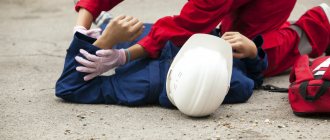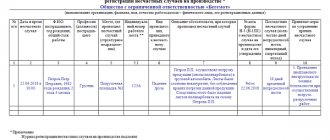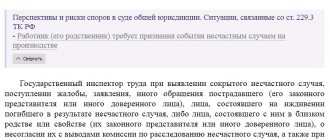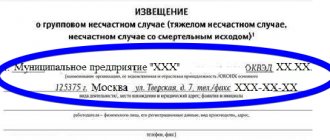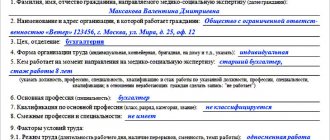Concept of work injury
Trauma is any damage to the tissues of the human body and disruption of the normal functioning of organs. If the accident is related to the performance of one’s official duties at the enterprise, it falls under the definition of an industrial injury.
Cases of health deterioration specific to a given profession are classified as occupational diseases. Workers receive them as a result of their work in hazardous conditions. The respiratory organs and musculoskeletal system are most often affected. In the Russian Federation there is a list of hazardous professions of categories 1 and 2 and diseases associated with them. It is valid throughout the country, for any organizations, regardless of their size and subordination.
Enterprises, depending on the technological process, have different categories of harmfulness. They negatively affect the body with the following phenomena:
- high and low temperatures;
- release of harmful gases into the atmosphere;
- strong light radiation;
- force fields;
- dustiness of the air;
- drafts;
- vibration;
- increased noise threshold;
- conditions of being underground or at height.
All these factors also relate to the causes of industrial injuries and occupational diseases.
At enterprises of the Russian Federation, all managers are obliged to take measures to prevent and reduce industrial injuries: fencing off dangerous places, providing workers with special clothing, improving working conditions, and others.
There are cases when it is impossible to completely eliminate the negative impact on a person. For example, working in northern conditions, especially in open areas. Most often these are builders, drivers, forestry workers, and sailors.
In the south, agricultural workers are forced to spend all day in the field under the rays of the scorching sun at air temperatures above +30 ⁰C. Under similar conditions, workers construct buildings, lay pipelines and other communications.
Influence of the place where the incident occurred
By understanding what types of work-related injuries there are, a person will find out that where the accident occurred is also taken into account.
Video
The situation arises:
- during a business trip or on the way to its destination (injuries during return are also considered work-related);
- on the territory of the organization during breaks or during working hours;
- when returning home, but only if the person returned using transport provided by the organization;
- when eliminating accidents or their consequences;
- during unforeseen situations at work sites;
- the maintenance of the main mechanisms was disrupted, and the incident occurred under their influence during the working day or after its completion;
- when performing official tasks during which personal transport or an organization car was used.
Occupational and non-occupational injuries
The causes of industrial injuries are classified according to the location where the accident occurred:
- in production;
- outside the enterprise while performing official duties;
- on the way to work and home;
- on the territory of the enterprise not related to production;
- household
Work-related injuries include those sustained on the territory of the enterprise while performing actions related to job responsibilities. When a worker or employee performs his work directly at the workplace. These include injuries sustained during the lunch break.
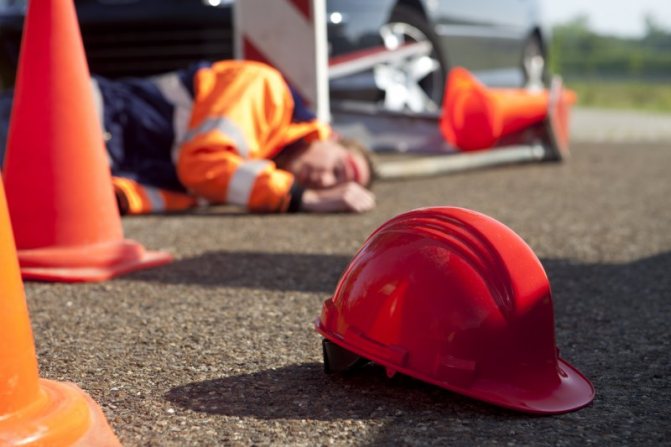
Occupational injuries can occur outside the enterprise, when a person is on a business trip, driving a company vehicle, going to work and home after a shift. If his movement or activity is related to the performance of duties specified in the employment contract and movement to and from the place of their implementation.
Coming home from work has its limitations. This is not the entire route home, but only the route directly from work to your place of residence. For example, after a worker entered a store and then fell and twisted his ankle, he should no longer leave work. An injury sustained before entering a retail or other establishment may be considered an industrial injury. Official transport and travel in it are considered being at work.
Not all injuries sustained on the premises of an enterprise are considered occupational injuries. Injuries received by a stranger or during free time are not considered industrial injuries and are considered accidental.
Domestic injuries are not related to the worker’s performance of his duties, and the accident occurs outside the enterprise.
Similarly, during a long business trip, occupational injuries include injuries received in a specific place. If it is impossible to strictly delimit the territory for performing his duties, for example, the supplier visits many organizations. In this case, the limitation is made in time.

From 8 a.m. to 5 p.m., the employee performs official duties. If a dispatched specialist falls in the evening, then it is a domestic injury.
Distinctive features and nuances
In accordance with Articles 227-231 of the Labor Code of the Russian Federation, all accidents occurring at work are classified into 4 main types, which include severe, fatal, group and those that are not classified as severe. In such a situation, it is necessary to understand that the employer cannot draw independent conclusions regarding what type of NS it is. Only doctors have this right, and classification into one or another type occurs when contacting a medical institution directly to record an injury or provide assistance. Severe ones include a fairly large list of emergency situations, among which the following health damages can be distinguished:
- Significant blood loss;
- Coma state;
- Acute respiratory failure;
- Fracture of facial bones or skull bones;
- Intracranial injury;
- Dislocation of the cervical vertebra;
- Vertebral fractures;
- Abdominal wound penetrating into the peritoneal cavity;
- Open fractures of long tubular bones;
- Thermal burns, if the area of damaged skin of the victim exceeds 15%;
- Termination of pregnancy and so on.
Upon receiving information from a medical institution that the emergency situation will be classified as severe, the employer must immediately take measures to inform the responsible authorities, to whom information should be conveyed in such a situation. The employer is obliged to report such a case to the prosecutor's office (territorial office), the Department of State Labor Inspection, a higher organization, and in the absence of one, the body where the employer is directly registered or insured, a trade union or any other body that directly represents the interests of employers. Separately, you will need to notify the enterprise or firm that acts as the victim’s employer if he is on the staff of another organization.
Classification of injuries by type
The causes of industrial injuries are divided into objective and accidental. The latter include isolated accidents on the territory of the enterprise that are not related to work or the specifics of production. For example, a person twisted his leg out of the blue or stared at welding and “caught bunnies” and suffered eye damage.
Objective reasons include:
- technical;
- sanitary and hygienic;
- organizational;
- physiological – personal.
The largest number of work-related injuries occur due to technical reasons. This is a malfunction of equipment and tools, poor insulation of power cables.
The workplace must have protective screens and shields that protect against the ingress of chips, scale and other dangerous objects.
Welding stations are fenced around the perimeter to protect the eyes of people passing by. The worker himself must wear a special suit and protective equipment in the form of glasses, boots, and gloves.
Sanitary and hygiene reasons
Reasons that are sanitary and hygienic factors that negatively affect health:
- bad light;
- drafts;
- low and high temperatures;
- air pollution;
- evaporation of harmful substances;
- poor ventilation;
- vibration;
- noise:
- lack of sanitary facilities.

In a poorly lit workshop, you may not notice the dangerous movement of individual pieces of equipment, a crane carrying a load, or an approaching electric vehicle. Drafts and cold provoke colds, inflammation, and the development of occupational diseases. The lack of household premises violates the standards of personal hygiene of people.
With poor ventilation, harmful substances accumulate in the air, which enter the respiratory system, affect the mucous membranes and blood, and cause occupational diseases.
Drafts, vibration and noise gradually cause irreversible processes in the human body: chronic inflammation, tremors, diseases of the musculoskeletal system.
Poor organization of work areas
Organizational reasons often lead to injuries due to poorly cleared aisles and paths and unpaved sidewalks in winter. The enterprise administration must take care of:
- correct placement of equipment;
- compliance with transportation standards;
- training in safe working methods;
- fencing hazardous areas;
- creating storage areas;
- all employees have special clothing appropriate to their profession;
- installation of sound and light alarms on all lifting and transport mechanisms.
The organization of labor begins outside the territory of the enterprise. What sidewalks do people use to get to the enterprise? The condition of the tracks at the plant itself. If there are holes and debris everywhere, then the likelihood of foot injury increases sharply.

Violation of transportation rules, improper slinging and stacking of cargo leads to its fall. Clogged aisles and driveways threaten to bring down everything that has accumulated in them onto people passing and driving by.
High-risk areas should be fenced and accessible only to people working there. For example, the crane cabin must be closed. The key is kept by the workshop mechanic and is given only to the crane operator who starts her shift. Similarly, chemical equipment, electrical devices and vibration stands are installed in separate rooms.
The availability of regularly issued protective clothing and the use of protective equipment are important factors in reducing occupational injuries.
Regular training of workers in safe work practices should not be neglected. In addition to information, constant verification of this knowledge is necessary. Each employee should know the scope of their responsibilities and not try to do someone else’s work. The machine operator should not independently remove and install large parts on the machine if he does not have a sling operator’s license. Likewise, the crane operator listens to commands and works only with persons who have passed a special exam and have a document.
With the noise of the equipment, it is difficult to hear approaching vehicles. Loads moving at height are especially dangerous. Therefore, all cranes, machines, electric trolleys must be equipped with signals that are sharply different in nature from the hum of machine tools, welding installations and other units.
Sanitary
At the beginning of the shift, the worker must change into overalls in normal conditions, where there are no drafts and it is warm. After your shift, wash yourself and remove any dirt that has ingrained your skin and contains harmful substances. During the shift, depending on the profession and working conditions, rest breaks are taken. The worker should be able to spend 10 to 15 minutes in comfortable conditions.
If the enterprise does not have a canteen, rooms for meals must be equipped. In addition to the table and chairs, they are equipped with equipment for heating food, a boiler or an electric kettle with boiling water.
Psychophysical
Physiological causes of injuries are called personal. They depend on the state and mood of the person. For example:
- accumulation of fatigue;
- bad feeling;
- nervous overload;
- stressful state;
- monotony of work.
When assigning a job, the physical characteristics of the body and anthropometric data should also be taken into account. For example, in schools for training machine operators, the height and gender of the graduate were always taken into account during the distribution. The tallest and strongest guys were placed on large machines. The girls received turning machines DIP 100 and small single-column planing and drilling units. On them, the weight of the workpiece does not exceed 10 kg, the tool 2 kg.

The master should not allow a person in poor health to perform his duties. His inattention will lead to industrial injuries. The patient should be referred to a doctor.
Special attitude towards persons under the influence of alcohol. They should be immediately suspended from work and an act of violating safety regulations and being drunk at work should be drawn up. This is as serious an offense as driving while intoxicated.
Causes of occupational diseases
Occupational diseases are a type of industrial injury, but they arise gradually, usually of the same type in people working in equally harmful conditions. They are provoked by:
- outdated technologies;
- unequipped workplaces;
- poor sanitation;
- failure to use protective equipment;
- retreat from technology;
- the need for contact with harmful substances.
When creating casting molds, the mixture is compacted by vibration. Molders fill the following boxes directly between the shakers. The floor is constantly shaking. Similarly, there are large machines with platforms for installing parts and turning on equipment. The lack of modern instruments showing the exact coordinates of the cutter and load forces the worker to stand on a vibrating metal platform for a long time. This gradually leads to industrial injuries - damage to the musculoskeletal system.
Galvanic baths and containers for electrolysis must be covered with lids on top. Vapors are removed into ventilation ducts. Active forced ventilation is installed in the room. Older equipment does not have such protective measures. Workers inhale harmful fumes.
A large percentage of diseases are caused by drafts and working at low temperatures indoors or outdoors in freezing temperatures. For work in winter conditions, in addition to special clothing, a schedule of heating and hot meals, and warm bathrooms are provided.
Classification of industrial injuries
To simplify analysis and statistics, all types of industrial injuries are classified according to several parameters:
- degree of severity;
- type of injury;
- one person or 2 or more are injured;
- according to the place where they occur most often.
In accordance with GOST on industrial injuries, the degree of severity distinguishes between mild, moderate and severe injuries. Separately, they are fatal. Special commissions are created for them and prosecutors are involved in the investigation.
According to the type of injury, they are distinguished:
- cuts;
- bruises;
- fractures;
- burns;
- poisoning

Cuts of varying severity most often occur when working with sharp instruments or piercing objects. For example, cooks using knives when cutting and cutting food. Construction workers installing barbed wire fencing or working with glass. Machine operators have sharp edges on their cutters. Drain shavings cut deep into the body.
Slippery floors, spilled oil, parts and containers protruding into the passage lead to varying degrees of bruises.
Fractures occur when a person falls, as well as heavy objects on him. A loose part, a hole in the road or poor lighting can cause serious damage.
Burns are divided into: thermal, chemical, electrical. Thermal ones occur upon contact with hot objects. Chemical burns are caused by contact with acids, alkalis and other harmful substances that corrode skin and tissue. In case of electric shock, an electrical burn appears at the site where the wire touches.
For example, in metallurgy, workers most often suffer thermal burns. It is not necessary to touch the hot workpiece. Standing nearby without appropriate felt clothing is enough to cause burns to exposed skin. The temperature of the molten metal is 1500 ⁰C and higher.
Each enterprise has an occupational safety department that investigates and properly records every accident. In addition to the type, the severity, cause of injury and location are indicated. All data is analyzed, statistics are compiled that identify the most dangerous places and professions.
Concept and examples
An accident of this type is characterized by causing serious harm to the worker’s health.
The main signs of such trouble can be considered the following:
- development of complications due to injuries received;
- development of chronic diseases;
- receiving injuries that threaten the health of the worker;
- complete loss of ability to work or death of the employee.
If at least one of the above circumstances is present, the accident is classified as serious.
The fact of a serious accident is also asserted in a situation in which an employee in the course of performing his work received the following injuries:
- pathologies, the development of which is accompanied by a state of shock, coma, large blood loss, embolism and disruption of the functioning of vital systems;
- The injuries that were recorded by a medical specialist during the initial examination of the injured worker were expressed as follows:
- brain contusion;
- various types of fractures;
- burns;
- knife wounds;
- abortion;
- loss of hearing, speech and vision;
- loss of any organ or loss of its functionality;
- psychological disorders;
- facial disfigurement;
- loss of reproductive function.
There are many examples of serious accidents. Most often, employees are injured as a result of work structures being in an inappropriate condition.
For example, a heavy object or installation may fall on an employee’s head. Getting into an accident while participating in traffic on a work vehicle is another example of a similar situation.
While working in a car service center, an employee burned his hands with hot oil. As a result, he received 3rd degree burns. The injury was sustained in the course of the performance of one's official duties and is therefore a typical example of a serious accident.
What to do - procedure
In the event of a serious accident, the employer must follow a certain procedure:
- Organizing emergency medical care for an injured employee, calling specialists, transporting the employee to the hospital.
- Taking measures to prevent the development of emergencies in order to ensure an adequate level of safety for other employees.
- Ensuring the safety of the current situation (provided that this does not aggravate the current situation). This is necessary to assess the scene of the incident during further investigation. If this is not possible, the manager must take a photo or video of the object.
- Notifying the relevant authorities and services about the accident. The list of such organizations is reflected in the Labor Code of the Russian Federation and other regulatory documents.
- Organization of the investigation - preparation of the necessary documentation.
In each case, the employer is obliged to inform certain persons about the incident. Their complete list depends on the severity of the situation.
Investigation procedure
A special commission is created to investigate a serious accident.
In this situation, the commission should include:
- occupational safety specialist;
- an employee representing the interests of the employer;
- trade union department worker;
- labor protection inspector;
- a person representing the interests of executive authorities or self-government bodies.
In some cases, the commission may include a representative of Rostechnadzor of the Russian Federation. An official of the federal executive body whose powers include monitoring the implementation of labor law norms is appointed as the head of the commission.
In the process of conducting an investigation, a set of measures is carried out:
- interviewing witnesses to the incident;
- searching for information about the details of the situation;
- generation of materials for investigation;
- clarification of the circumstances under which a severe case was recorded;
- determining the causes of the problem;
- searching for a connection between the accident and production;
- determination of the degree of guilt of the victim (in percentage).
If necessary, members of the commission assign additional procedures to the employer, which he must carry out at the company’s expense:
- involvement of various experts in the investigation;
- conducting laboratory research;
- drawing up diagrams or sketches of the place where the accident occurred;
- photo or video shooting of the object;
- provision of a vehicle, premises, clothing and footwear of a specialized type.
During the investigation process, relevant documents are generated. Their approximate list is reflected in Article 229 of the Labor Code of the Russian Federation.
According to the information indicated therein, the following papers are subject to registration:
- order on the creation of the relevant commission;
- act of investigating what happened;
- photo and video materials;
- papers that reflect the state of the employee’s workplace;
- extracts of their job descriptions and other similar instructions;
- protocols containing the testimony of witnesses;
- a medical report describing the injuries inflicted on the injured worker.
If necessary, other documents may be prepared. At the end of the investigation, a special act is created, which reflects its result.
During the investigation, the available case materials are studied and the condition of the workplace in which the accident occurred is assessed. The organization and degree of provision of the labor protection system, etc. are checked.
Deadlines
In accordance with labor regulatory documentation, the beginning of the investigation period should be considered the day of execution of the act on the creation of the commission.
A period of 15 calendar days is allocated to conduct an investigation into the situation. If the employer did not learn about the accident in a timely manner, the investigation period may be extended to 1 month.
If necessary, the standard investigation period may be extended by 15 days.
The decision on the extension has the right to be made by the chairman of the commission.
Specialists from authorized bodies and services taking part in the investigation can also influence the duration of this time.
